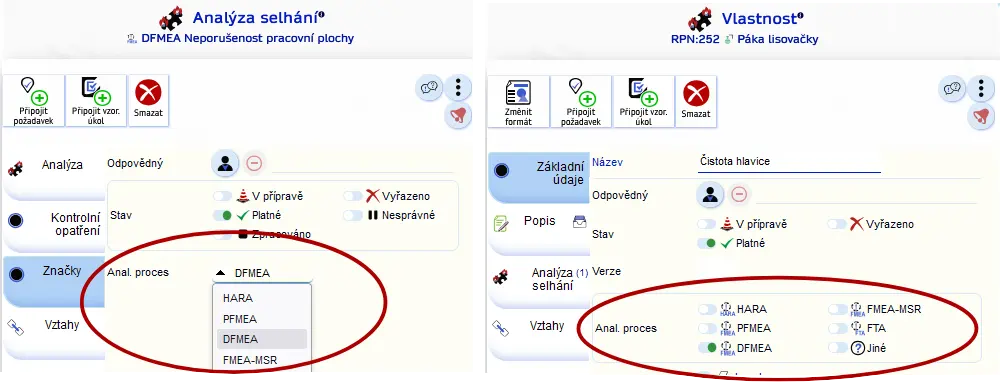AyMINE – Technical documentation
Modules
 Task, project & quality management
Task, project & quality management
Manager approval with the task report
Why some data can't be deleted
Adminitration of areas, projects, calendars
Region / project / methodology
Change management process in a project
GDPR and record of qualifications
Qualification of user or contact
Right to Manage Qualifications
Failure Analysis for an Individual Property of a Component or Process
FMEA – Probability of Detection
FMEA – Probability of Occurrence
 Task, project & quality management
Task, project & quality management
Administration of the Task Management Module
System rights for the task management module
Improvements and Preventive Measures
Methodology and Quality Management systems
What a methodology / QMS consists of
Problems, tickets and their management
Collaborative Resolution of Multiple Problems
Customer Service Response Generation
Incident and Quality Issue Management
Objects affected by the problem
Problems, Incidents, Helpdesk Tickets
Return project plan by baseline
Sample tasks and methodologies of the area
Effect of the task on the right to modify the attached object
The person responsible for the task
Working procedure – task definition
Objects related to the task pattern
 Contacts and directories module (CRM)
Contacts and directories module (CRM)
Order overview for customer groups
 Contacts and directories module (CRM)
Contacts and directories module (CRM)
System Permissions and CRM Module Settings
Send bulk messages in compliance with GDPR
How to correctly forget a person's details
Unsubscribe and set preferences
for bulk mail
 Web management and automation
Web management and automation
Receiving a message from the web
Human resources
Personalistics – User Permissions
Human Resources module security
Manage department / division data
Overview of Personnel Information for pracov# Employment Contract
Synchronizing staff and system users
 Products, assets and sales
Products, assets and sales
Received order for goods or services
Finance management
Metrics and Measurements
Technical Modules
Sabre plugin module
Enterprise Architect connector
Database link to Enterprise Architect database
Enterprise Architect connector
System Modules
 The AyMINE Framework Module
The AyMINE Framework Module
AyMINE — Tips for Mobile Usage
Configure how your system looks and works
Gestures and Keyboard Shortcuts
More about how the system works
Private notes and tags for objects
Overview of Modules and Record Types
Filtering in the list of records
 System Management
System Management
Additional functions with files
Copying and moving files between objects
Files (documents) linked to the object
Formatted texts in the application
Gateway settings for external messages
IMP gateway settings for email communication
Internet Call Gateway Settings
Message with the outside world
 FMEA – Probability of Occurrence
FMEA – Probability of Occurrence
Probability of Failure Occurrence
The definition varies for different types of FMEA analysis. Therefore, you need to specify the type of the analytical process (for individual failures or for properties).

The overview below is based on standards for the automotive industry. Before use, ensure it is relevant for your case!
DFMEA
Level 1: Any design failure removed by standard QA procedures
Level 2: Developed according to known standards and tested
Level 3: Only minor design changes, in accordance with development standards
Level 4: Minor operational cycle changes, errors detected by preventive measures
Level 5: Design change, development uses known technologies and materials
Level 6: Lifecycle changes that may bring unexpected problems
Level 7: New design solution where preventive measures may not reveal issues
Level 8: First use of innovations where known preventive measures do not uncover issues
Level 9: New technologies and processes with no experience in the team or company
Level 10: New technologies/processes with no general experience
PFMEA
Level 1: Risk eliminated by QA, defects eliminated by physical protection
Level 2: ≤ 0.001 out of thousand (6σ) failures, highly effective control using proven techniques
Level 3: 0.01 out of thousand failures, highly effective control using proven techniques
Level 4: Low occurrence; technical or behavioral controls that effectively detect defects
Level 5: Medium occurrence; technical or behavioral controls that effectively detect defects
Level 6: High frequency of occurrence; technical or behavioral controls partially preventing defects
Level 7: Greater frequency of occurrence; technical or behavioral controls partially preventing defects
Level 8: High frequency of occurrence; behavioral controls with low certainty of preventing defects
Level 9: Very high frequency of occurrence; behavioral controls with low certainty of preventing defects
Level 10: Extremely high frequency; control is not possible or defect prevention is unachievable
FMEA-MSR
Level 1: Failure cannot occur during its lifetime. Justification is documented
Level 2: Assumed but not proven that the product will not fail during operation, or the product will not reach operational status
Level 3: Isolated failure cases may occur; assumption of at least 1 occurrence
Level 4: Assumed at least 10 occurrences
Level 5: Occasionally fails during its lifetime
Level 6: Fails relatively more often
Level 7: Commonly fails
Level 8: Frequently fails during its lifetime
Level 9: Likely to fail
Level 10: Unknown how often failure occurs, or it is unacceptably frequent during operation